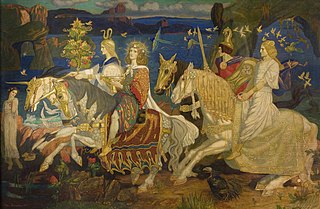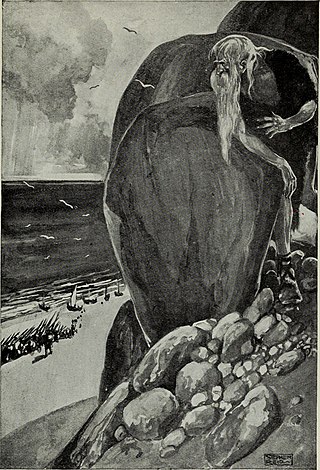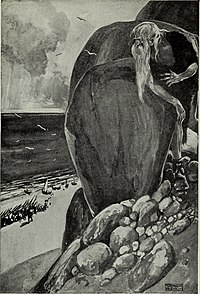
Irish mythology is the body of myths native to the island of Ireland. It was originally passed down orally in the prehistoric era, being part of ancient Celtic religion. Many myths were later written down in the early medieval era by Christian scribes, who modified and Christianized them to some extent. This body of myths is the largest and best preserved of all the branches of Celtic mythology. The tales and themes continued to be developed over time, and the oral tradition continued in Irish folklore alongside the written tradition, but the main themes and characters remained largely consistent.

Lugh or Lug is a figure in Irish mythology. A member of the Tuatha Dé Danann, a group of supernatural beings, Lugh is portrayed as a warrior, a king, a master craftsman and a savior. He is associated with skill and mastery in multiple disciplines, including the arts. Lugh also has associations with oaths, truth and the law, and therefore with rightful kingship. Lugh is linked with the harvest festival of Lughnasadh, which bears his name. His most common epithets are Lámfada[ˈl̪ˠaːw ad̪ˠə] and Samildánach[ˈsˠawˠil d̪ˠaːnˠəxˠ].

The TuathaDé Danann, also known by the earlier name Tuath Dé, are a supernatural race in Irish mythology. Many of them are thought to represent deities of pre-Christian Gaelic Ireland.

In Irish mythology, Nuada or Nuadu, known by the epithet Airgetlám, was the first king of the Tuatha Dé Danann. He is also called Nechtan, Nuadu Necht and Elcmar, and is the husband of Boann. He is mostly known from the tale in which he loses his arm or hand in battle, and thus his kingship, but regains it after being magically healed by Dian Cécht. Nuada is thought to have been a god and is related to the British and Gaulish god Nodens, who is associated with hunting and fishing. His Welsh equivalent is Nudd or Lludd Llaw Eraint.
In Irish mythology, Goibniu was the metalsmith of the Tuatha Dé Danann. He is believed to have been a smithing god and is also associated with hospitality. His name is related to the Welsh Gofannon and the Gaulish Gobannus.
In Irish mythology, Balor or Balar was a leader of the Fomorians, a group of malevolent supernatural beings. He is often described as a giant with a large eye that wreaks destruction when opened. Balor takes part in the Battle of Mag Tuired, and is primarily known from the tale in which he is killed by his grandson Lugh of the Tuatha Dé Danann. He has been interpreted as a personification of the scorching sun, and has also been likened to figures from other mythologies, such as the Welsh Ysbaddaden and the Greek Cyclops.
Bé Chuille, also known as Becuille and Bé Chuma, is the daughter of Flidais and one of the Tuatha Dé Danann in Irish mythology. In a tale from the Metrical Dindshenchas, she is a good sorceress who joins three other of the Tuatha Dé to defeat the evil Greek witch Carman. According to the Book of Leinster (1150) Bé Chuille was killed, along with Dianann, by "gray demons of air." During the second Second Battle of Moytura, Bé Chuille and Dianann are called Lugh's two witches, and when asked what they will do in battle, they respond that they will enchant the trees, stones, and grasses of the earth to route the Fomorians with horror and affliction. In the Lebor Gabála Érenn Bé Chuille and Dianann are called "she-farmers" and mentioned along with their sisters Argoen and Be Theite as the daughters of Flidais.
Cessair or Cesair is a character from a medieval Irish origin myth, best known from the 11th-century chronicle text Lebor Gabála Érenn. According to the Lebor Gabála, she was the leader of the first inhabitants of Ireland, arriving before the Biblical flood. The tale may have been an attempt to Christianize an earlier pagan myth.

Nemed or Nimeth is a character in medieval Irish legend. According to the Lebor Gabála Érenn, he was the leader of the third group of people to settle in Ireland: the Muintir Nemid, Clann Nemid or "Nemedians". They arrived thirty years after the Muintir Partholóin, their predecessors, had died out. Nemed eventually dies of plague and his people are oppressed by the Fomorians. They rise up against the Fomorians, attacking their tower out at sea, but most are killed and the survivors leave Ireland. Their descendants become the Fir Bolg and the Tuatha Dé Danann.

In medieval Irish myth, the Fir Bolg are the fourth group of people to settle in Ireland. They are descended from the Muintir Nemid, an earlier group who abandoned Ireland and went to different parts of Europe. Those who went to Greece became the Fir Bolg and eventually return to Ireland, after it had been uninhabited for many years. After ruling it for some time and dividing the island into provinces, they are overthrown by the invading Tuatha Dé Danann.
Ogma is a god from Irish and Scottish mythology. A member of the Tuatha Dé Danann, he is often considered a deity and may be related to the Gallic god Ogmios. According to the Ogam Tract, he is the inventor of Ogham, the script in which Irish Gaelic was first written.
Partholón is a character in medieval Irish Christian pseudo-history, who is said to have led one of the first groups to settle in Ireland. 'Partholón' comes from the Biblical name Bartholomaeus (Bartholomew), and may be borrowed from a character who appears in the Christian pseudo-histories of Saints Jerome and Isidore of Seville.

Lebor Gabála Érenn, (Modern Irish spelling: "Leabhar Gabhála Éireann") known in English as The Book of Invasions, is a collection of poems and prose narratives in the Irish language intended to be a history of Ireland and the Irish from the creation of the world to the Middle Ages. There are a number of versions, the earliest of which was compiled by an anonymous writer in the 11th century. It synthesised narratives that had been developing over the foregoing centuries. The Lebor Gabála tells of Ireland being settled six times by six groups of people: the people of Cessair, the people of Partholón, the people of Nemed, the Fir Bolg, the Tuatha Dé Danann, and the Milesians. The first four groups are wiped out or forced to abandon the island; the fifth group represents Ireland's pagan gods, while the final group represents the Irish people.
In Irish mythology Fintan mac Bóchra, known as "the Wise", was a seer who accompanied Noah's granddaughter Cessair to Ireland before the deluge. Bóchra may be his mother, or may be a poetic reference to the sea.

The Mythological Cycle is a conventional grouping within Irish mythology. It consists of tales and poems about the god-like Tuatha Dé Danann, who are based on Ireland's pagan deities, and other mythical races such as the Fomorians and Fir Bolg. It is one of the four main story 'cycles' of early Irish myth and legend, along with the Ulster Cycle, the Fianna Cycle and the Cycles of the Kings. The name "Mythological Cycle" seems to have gained currency with Arbois de Jubainville c. 1881–1883. James MacKillop says the term is now "somewhat awkward", and John T. Koch notes it is "potentially misleading, in that the narratives in question represent only a small part of extant Irish mythology". He prefers T Ó Cathasaigh's name, Cycle of the Gods. Important works in the cycle are the Lebor Gabála Érenn, the Cath Maige Tuired, the Aided Chlainne Lir and Tochmarc Étaíne.
Lebor na hUidre or the Book of the Dun Cow is an Irish vellum manuscript dating to the 12th century. It is the oldest extant manuscript in Irish. It is held in the Royal Irish Academy and is badly damaged: only 67 leaves remain and many of the texts are incomplete. It is named after an anachronistic legend that it was made from the hide of a dun cow by Saint Ciarán of Clonmacnoise.
In Irish mythology Conand was a leader of the Fomorians who lived in a tower on Tory Island. He oppressed the followers of Nemed, demanding a huge tribute of their produce and children. Eventually Nemed's people rose up and killed him, destroying his tower. After his death, Morc, another Fomorian massacred Nemed's surviving followers.

Finnian of Movilla was an Irish Christian missionary. His feast day is 10 September.
Early Irish literature is one of the oldest vernacular literatures in Western Europe, though inscriptions utilising Irish and Latin are found on Ogham stones dating from the 4th century, indicating simultaneous usage of both languages by this period of late antiquity. According to Professor Elva Johnston, "the Irish were apparently the first western European people to develop a full-scale vernacular written literature expressed in a range of literary genres". A significant number of loan words in Irish from other Indo-European languages, including, but not limited to Latin and Greek, are evidenced in Sanas Cormaic, which dates from the 9th century. Two of the earliest examples of literature from an Irish perspective are Saint Patrick's Confessio and Letter to Coroticus, written in Latin some time in the 5th century, and preserved in the Book of Armagh.
In Irish mythology, Cian or Cían, nicknamed Scal Balb, was the son of Dian Cecht, the physician of the Tuatha Dé Danann, and best known as the father of Lugh Lamhfada. Cían's brothers were Cu, Cethen, and Miach.








